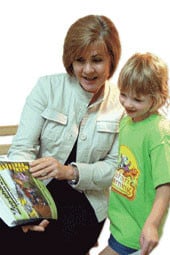What do homeschoolers find most appealing about the Zoo-phonics Program?

The joy that Zoo-phonics brings into the home classroom through the Animals, the movement, music, game format and through the ease with which the children learn the basics of reading, spelling and writing.
How is the Zoo-phonics Program used in a homeschool setting?
The presentation of Zoo-phonics is much the same whether in a classroom or homeschool setting. Each Animal/Picture, in the shape of the letter, is presented to the child giving all three modalities at the same time: 1) visual; 2) auditory; and 3) kinesthetic. Holding up the picture, you and you’re your children say, in unison, “allie alligator, ‘a’.” At the same time, they stretch out their arms and give a clap to represent the alligator’s snapping jaws.
Which Zoo-phonics Program is best suited for home school use?
There is only ONE Zoo-phonics Program and methodology. The best option for the homeschool classroom is the teachers’ program(s).
What makes Zoo-phonics different?
Zoo-phonics: (a) Uses 26 animals to teach letter shapes and sounds. (b) Teaches the lowercase letters before introducing capitals. (c) Teaches letter sounds before letter names. (d) Teaches a body movement, or “signal,” in association with each Animal/letter of the alphabet. These “Signals” aid memory and bring fun into the classroom. (e) Treats the alphabet as a whole and goes from “a-z.” (f) Teaches short vowels before long vowels. (g) Uses “word family” patterns to teach reading and spelling, because children are “naturals” at finding and remembering patterns.
In Zoo-phonics, we take something that is very abstract (reading) and through music, stories and games, turn it into something that is concrete and understandable to young children.
How does Zoo-phonics differ from the traditional method of teaching phonics?
Zoo-phonics teaches lowercase letters and sounds first. When these have been learned, uppercase letters and letter names are introduced. The alphabet is taught as a whole and in sequence. Zoo-phonics does not believe in teaching one letter per week. It teaches the alphabet from “a-z.” To make it fun, the children sing and move to the Zoo-phonics alphabet song entitled, “Come Meet us at the Zoo” (from the Zoo-Music Collection On CD). A Body Signal is taught from “a-z” in association with each Animal. Not only is this beneficial to a young child’s physical development, but it aids memory (for “When the body moves, the brain remembers”), and it’s fun!
